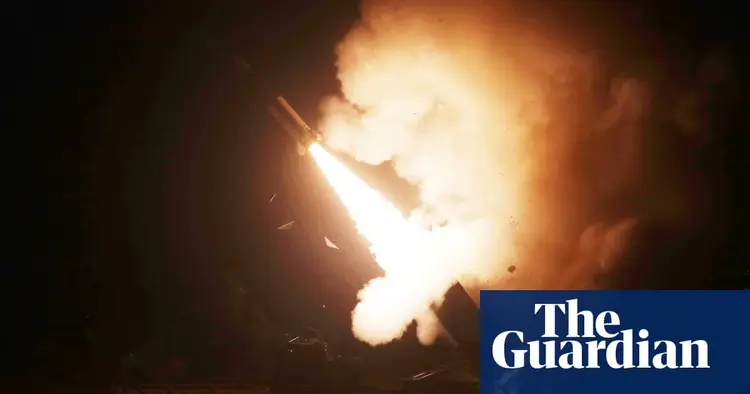Letting Ukraine fire missiles into Russia unlikely to have decisive effect

It took a defeat in the US elections and the arrival of 10,000 North Koreans in Ukraine for Joe Biden to change his stance. After two years of requests, Ukraine’s military has now received the green light to use US long-range Atacms missiles to hit targets within Russia. The implications for both the military and political landscape are still unclear.
Throughout the conflict, Russia has successfully targeted various locations all over Ukraine. Recently, on Sunday, it launched strikes on crucial elements of the country's power infrastructure, which led Kyiv to enforce national electricity restrictions due to the extensive damage. Some missiles reached as far west as Lviv and hit areas close to the border with Moldova, heightening the risk of an energy crisis.
Before the large-scale invasion by Russia, Kyiv lacked a substantial long-range missile program and has faced restrictions from its Western allies ever since. While the US, UK, and France have provided long-range missiles, they have only permitted their use against targets within Ukraine's recognized borders. As a result, crucial facilities like airfields, fuel storage, logistics centers, and military barracks located in Russia have remained inaccessible to Ukraine, except for attacks carried out by drones.
According to leaks from the White House reported by US media on Sunday night, President Biden, with just two months left in his term, has authorized the use of Atacms missiles, which can hit targets up to 190 miles (300 kilometers) away, inside Russian territory. However, there seems to be a condition attached: these missiles should only be deployed in connection with the situation in the Kursk region. In that area, Russia, with assistance from North Korea, has assembled around 50,000 troops in an effort to counter Ukraine’s offensive that has been ongoing for three months.
"Interpreting the situation, it seems we're seeing more of a gradual approach," commented George Barros, a specialist on Ukraine at the US Institute for the Study of War. "It appears that the US intends for the Atacms missiles to be specifically aimed at the North Koreans in Kursk, but there is a significant amount of critical Russian support facilities in areas like Rostov, Belgorod, and Voronezh."
While there haven't been any reports of Atacms missile strikes occurring within Russia so far, some immediate repercussions are anticipated. It's probable that Russian military strategists will quickly relocate any assets they think could be vulnerable, if they can do so in a timely manner.
This could also be a worthwhile investment for the US, considering that Atacms are not widely available and the missiles themselves are relatively expensive, priced between $1 million and $2 million.
Barros mentioned that directly intimidating North Korea might have its advantages, especially since their involvement in the conflict would be extremely important. "Up to now, the reaction from the West has been rather tepid, and there are indications that North Korea could provide up to 100,000 troops to fight in Ukraine." Given that the fighting forces of Russia and Ukraine are estimated to be fairly evenly matched at around 600,000 to 700,000, preventing North Korea from sending additional soldiers could have a considerable impact.
As a potential Donald Trump presidency approaches, Ukraine is eager to demonstrate its capabilities on the battlefield, especially with support from the West. Matthew Savill from the Royal United Services Institute emphasized that Ukrainians must prove to the next US administration that they remain a worthy ally—essentially seen as a ‘sound investment’ in Trump’s pragmatic perspective.
In reaction to the situation, Western nations must address the increasing threats from Russia. However, as Savill highlights, the situation in Ukraine shows that Russia has already raised the stakes. Moscow is actively involved in an intensified campaign of sabotage throughout Europe, which includes assassination attempts on Western arms manufacturers and plans for arson. This even involves sending incendiary devices through the DHL service to targets in the UK.
In Ukraine, the strikes on power facilities and substations primarily impact ordinary citizens, especially when the power goes out. "Russia's tactic of intensifying attacks, particularly during holidays or weekends, aims to undermine the morale of Ukrainians and bring their attention back to the difficulties of wartime," explained Vladyslav Faraponov, who leads the board at Ukraine's Institute of American Studies.
Nevertheless, some specialists doubt that giving Ukraine broader access to Atacms for use within Russia would significantly change the outcome of the conflict. If the US permits this, it's possible that the UK, France, and Italy might also agree to provide additional Storm Shadow/Scalp missiles, which have a comparable range, and allow their use in Russia as well. However, it's worth noting that inventory is limited, and even with European and US permission—which supplies the missile's guidance system—there may not be enough available.
Ukraine is facing significant challenges in the eastern part of the country, as Russian troops are attempting to create a pocket that could surround Kurakhove to the south. Despite Russian losses reaching unprecedented levels, with around 1,500 soldiers killed daily, Moscow is trying to convince Trump and his associates that their success is unavoidable through ongoing attacks on the front lines. Meanwhile, Ukraine is dealing with a shortage of personnel and has not received the strong backing from Western allies that it has needed throughout the conflict.
"Ukrainians have gradually adapted to dealing with initial denials regarding crucial weapon supplies, which are often followed by uncertain affirmations and, only after many lives have been lost, an unwilling agreement. Sadly, this kind of reactive strategy isn't what Ukraine requires to maintain its independence or navigate possible negotiations," Faraponov remarked.
A delayed choice to ease restrictions on a specific type of missile doesn’t clearly provide the strong backing that Ukraine is seeking.









































